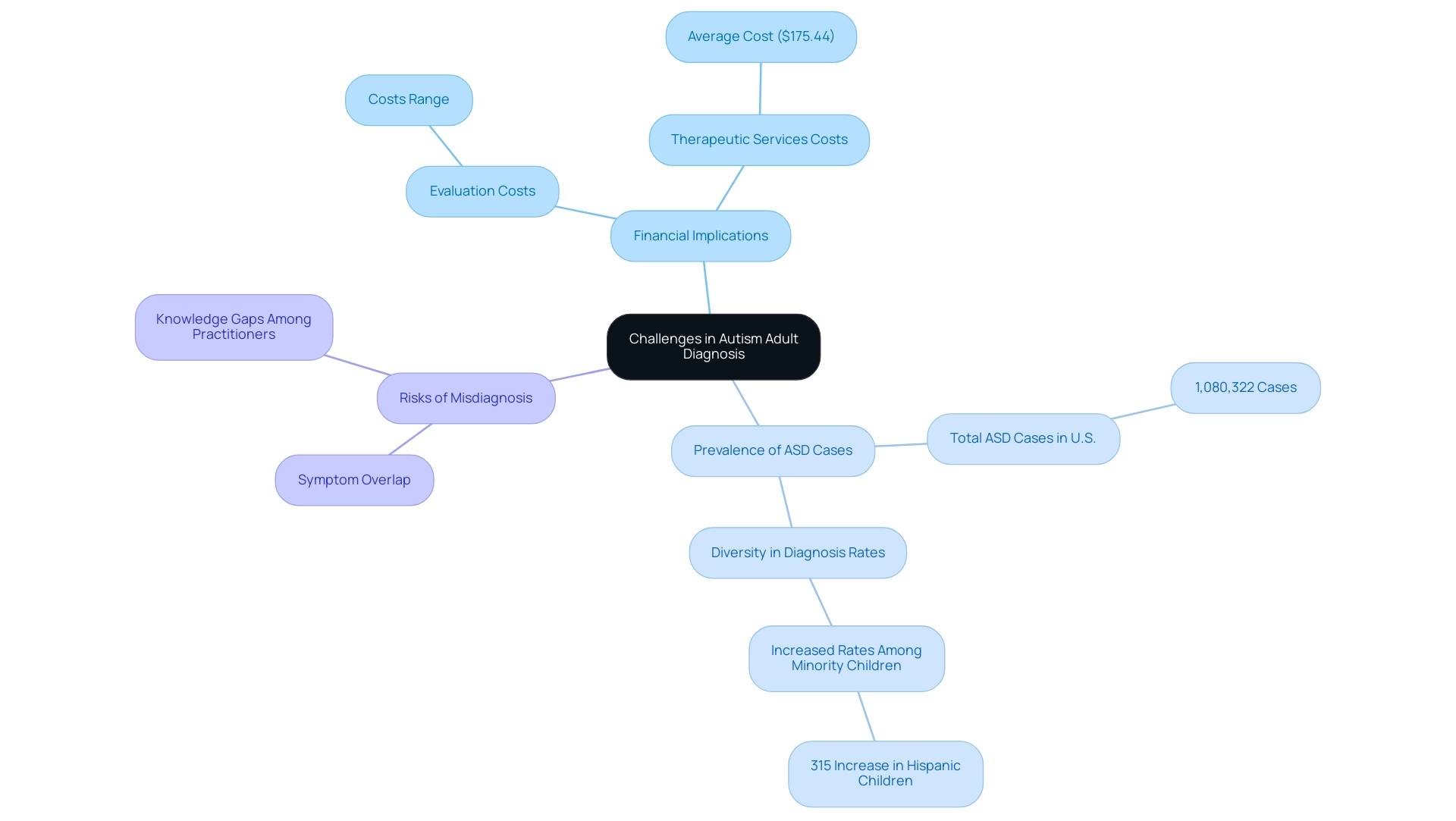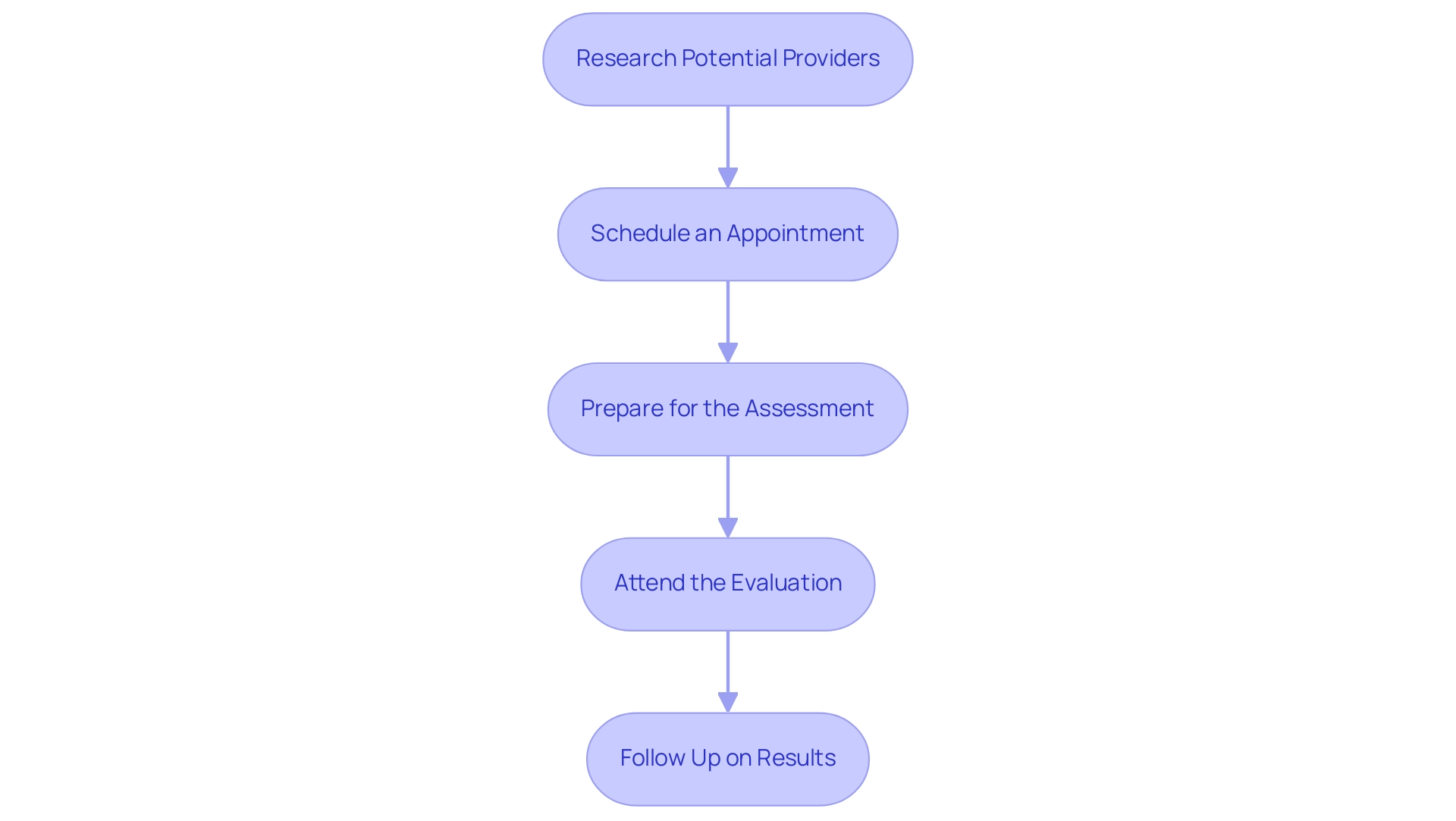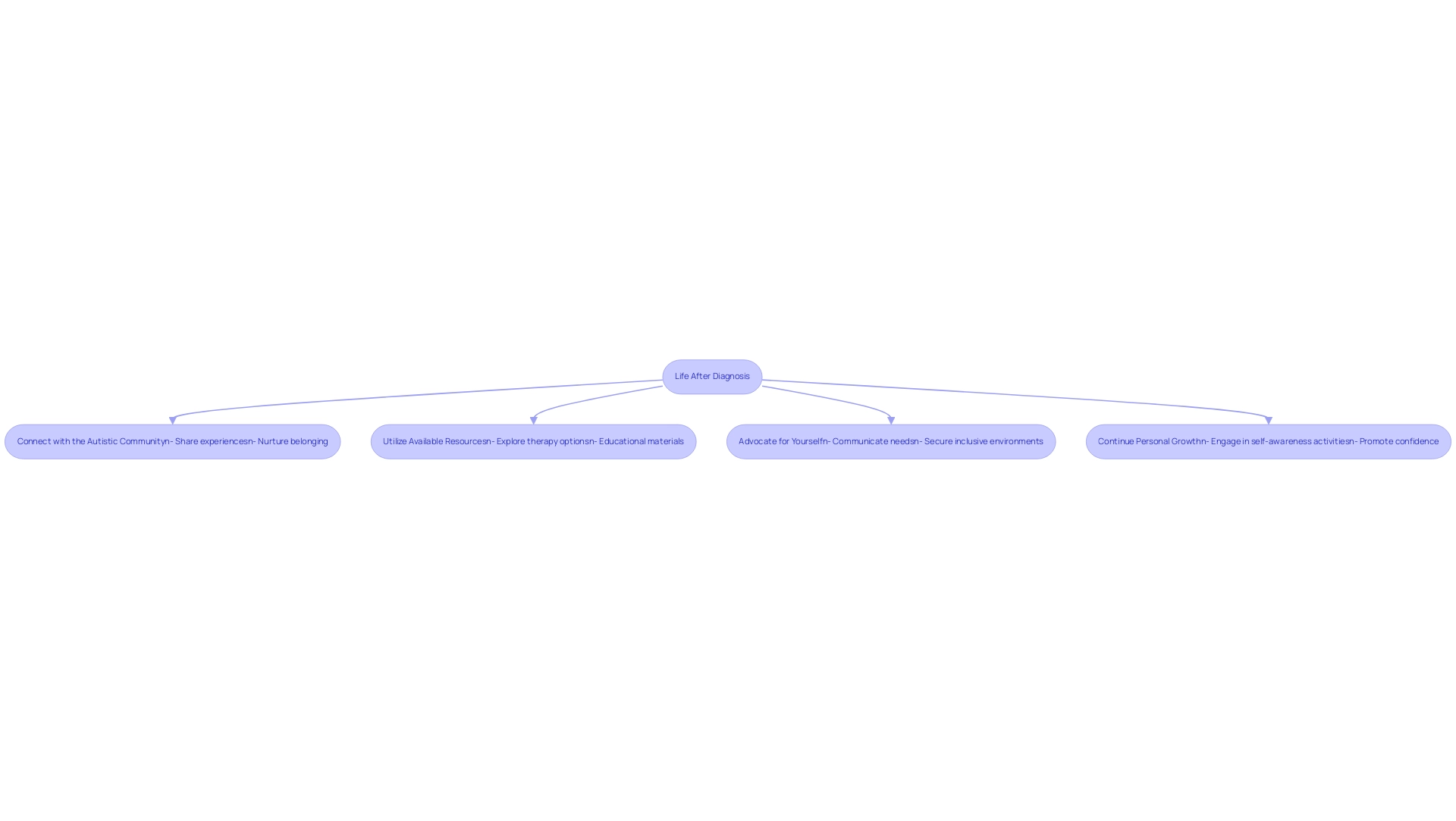Overview
Understanding adult autism diagnosis is crucial for individuals seeking clarity in their life journeys, despite facing challenges such as societal stigma and a complex diagnostic process. The article highlights that obtaining a diagnosis can empower individuals through self-acceptance and access to support resources, while also emphasizing the importance of navigating potential obstacles like financial costs and risks of misdiagnosis.
Introduction
In the complex landscape of adult autism diagnosis, the journey is often fraught with challenges yet filled with potential for profound personal growth and understanding. For many, receiving a diagnosis can be a transformative experience, shedding light on years of unrecognized struggles and paving the way for acceptance and empowerment.
However, the path to diagnosis is not without its hurdles; societal stigma, financial implications, and the risk of misdiagnosis can create significant barriers. This article delves into the importance of obtaining an adult autism diagnosis, the benefits it brings, and the practical steps individuals can take to navigate the process effectively.
By exploring the intricacies of diagnosis and the resources available, readers can find the support they need to embrace their unique journeys and foster a sense of belonging within the autism community.
Understanding Adult Autism Diagnosis: Importance and Challenges
Receiving [[an autism adult diagnosis in adulthood signifies a crucial milestone that can greatly clarify one's life journey. Yet, this journey is often laden with obstacles, including societal stigma, a general lack of awareness, and the intricate nature of the diagnostic process itself. Data from recent studies indicates that many adults may grapple with symptoms related to autism adult diagnosis for years, resulting in feelings of isolation and confusion.
For instance, a comprehensive review of medical records from 9 million individuals revealed that those with a sibling on the autism spectrum face an increased risk of developing Autism Spectrum Disorder (ASD) themselves. This statistic emphasizes not only the genetic factors involved but also the societal stigma that can prevent individuals from pursuing an autism adult diagnosis. Recognizing these challenges is essential for anyone considering an autism adult diagnosis medical assessment, as it prepares them to handle the potential obstacles ahead.
Moreover, it is essential for social workers to be educated to assist parents in planning for their child's future, breaking down the planning process into manageable steps. As Judy Singer aptly noted, the rainbow infinity sign symbolizes the inclusivity of all individuals on the spectrum, reinforcing the need for understanding and acceptance. Additionally, a recent case study titled 'Developmental Progress in Autistic Children' indicates that nearly a quarter of school-age autistic children are thriving across all five developmental areas, despite continuing to meet the criteria for Autism Spectrum Disorder (ASD).
This highlights the possibility of positive outcomes for autistic individuals, reinforcing the notion that success is achievable. Acknowledging the significance of assessment in the context of autism adult diagnosis not only validates personal experiences but also empowers individuals to pursue necessary resources and support systems. This proactive approach can transform their journey, fostering resilience and a greater sense of belonging.
The Benefits of an Autism Diagnosis: Empowerment and Support
For numerous individuals, obtaining an autism identification can be a transformative experience, fostering a deep sense of self-acceptance as they begin to comprehend their distinctive characteristics and actions through the perspective of autism. This newfound clarity often leads to emotional relief, joy, and validation for the challenges they have faced. As Sebastian, an adult with ASD, poignantly reflects,
After receiving the assessments which changed things for me emotionally and mentally and you know having accommodations and finally getting good grades in my life, you know?
I still struggled at work, I still struggled because the world isn't arranged for me…lacking assistance and accommodations, it just broke me. His experience highlights the fact that while assessment can clarify the way forward, the journey necessitates sufficient assistance and adjustments. Receiving an autism adult diagnosis not only opens doors to essential assistance services and therapeutic resources but also fosters connections within the neurodiverse community.
Engaging with others who share similar experiences can cultivate a sense of belonging and friendship, enriching the lives of individuals on the spectrum. Furthermore, statistics indicate that individuals diagnosed with ASD in later life are almost three times more likely to be diagnosed with mood, anxiety, or personality disorders compared to those diagnosed in childhood, emphasizing the necessity for prompt assistance. The prompt acknowledgment of neurodiversity, along with suitable assistance, can greatly improve the quality of life for individuals on the autism spectrum.
As research continues to advance, with efforts focused on improving diagnostic methods and early interventions, including the development of objective biomarkers and the use of artificial intelligence, the prospects for empowerment through assessment are becoming increasingly promising.
Navigating the Challenges: Costs and Misdiagnosis Risks
Navigating the pathway to an autism adult diagnosis for individuals on the spectrum can yield significant benefits, yet it is essential to remain aware of the challenges that may arise. The financial implications are considerable, with evaluations ranging from a few hundred to several thousand dollars based on the provider and geographical location. In 2024, the average cost of therapeutic behavioral services is approximately $175.44, which can accumulate quickly when seeking comprehensive assessments.
It is important to note that the total estimated ASD cases in the U.S. is approximately 1,080,322, underscoring the prevalence of the condition and the increasing demand for diagnostic services. Moreover, misdiagnosis poses a significant risk in autism adult diagnosis, often arising from symptom overlap with other conditions or a lack of knowledge among some practitioners concerning mature individuals with this condition. This concern is particularly relevant given the findings from the case study titled 'Racial and Ethnic Disparities in Autism Diagnosis,' which reported significant increases in autism diagnosis rates among minority children, highlighting the need for inclusive services for diverse populations.
These concerns are echoed by Andy Shih, chief science officer at Autism Speaks, who asserts:
This study is a significant step forward in our community. It indicates where we’re making progress, but also where we need to enhance, particularly regarding women, girls, and diverse communities.
To reduce the chances of misdiagnosis and guarantee a comprehensive evaluation, it is essential to consult specialists skilled in autism adult diagnosis.
Additionally, proactively inquiring about costs and the specifics of the evaluation process can empower individuals to make informed decisions that best support their needs and circumstances.

Steps to Getting Diagnosed: A Practical Guide
Navigating the path to a neurodevelopmental condition assessment as a grown-up involves several key steps that empower you to take charge of your journey:
- Research Potential Providers: Begin by seeking out psychologists or psychiatrists who specialize in assessments for autism adult diagnosis. Their expertise is crucial for accurate evaluation.
- Schedule an Appointment: Once you've identified a suitable provider, contact them to share your concerns and request an evaluation. This initial conversation is vital for establishing a relationship.
- Prepare for the Assessment: Gather and document your developmental history, including any challenges you’ve faced throughout your life. This information is essential in helping the evaluator understand your experiences.
- Attend the Evaluation: Approach the assessment with honesty and openness. Offering genuine responses enables the provider to make an informed and precise assessment.
- Follow Up on Results: After obtaining your assessment, engage in a discussion about the next steps and available resources. Collaborating with your provider to create a tailored support plan will be instrumental in your journey.
Roughly 5.4 million individuals in the U.S. live with this condition, emphasizing the significance of comprehending the assessment process and obtaining suitable resources. However, it is important to note that the data collected regarding developmental disorder prevalence primarily pertains to 8-year-olds and should not be extrapolated to older individuals. As noted by Maenner MJ, "Prevalence and Characteristics of Autism Spectrum Disorder Among Children Aged 8 Years — Autism and Developmental Disabilities Monitoring Network, 11 Sites, United States, 2020."
Furthermore, awareness of racial and ethnic differences in ASD prevalence is crucial, as improved screening and access to services may have contributed to increased identification of ASD among historically underserved groups. By following these steps and utilizing current guidelines for the autism adult diagnosis assessment process in 2024, you can advocate effectively for yourself or your loved ones.

Life After Diagnosis: Strategies for Integration and Support
Navigating life after receiving an autism adult diagnosis can indeed lead to a fulfilling journey filled with opportunities for growth and connection. Here are some empowering strategies to help you integrate and discover assistance:
-
Connect with the Autistic Community: Actively seek out local or online groups where you can share experiences and gather insights from others who understand your journey. Interacting with the community not only nurtures a sense of belonging but also offers invaluable assistance. Many individuals, like Participant 5, have expressed,
I feel less pressured to change how I approach things, but at the same time I recognize that maybe I can approach things in a different way, recognizing that I can be overly direct and overly blunt.
This type of reflection is typical among those who find communal assistance, emphasizing the significance of self-acceptance within a nurturing network. -
Utilize Available Resources: Explore therapy options, educational materials, and workshops specifically designed to enhance your understanding of autism. As recent studies indicate, there is a pressing need for more resources and services for both autistic individuals and their caregivers. This encompasses customized employment assistance services; for example, two individuals with intellectual disabilities have gained from such services, demonstrating the necessity for specialized resources that address distinct needs.
-
Advocate for Yourself: Empower yourself by learning to communicate your needs effectively in various settings, whether at work or in social situations. The study on employment challenges for autistic adults emphasizes the significant barriers many face, including difficulties during job interviews and navigating workplace communication, particularly in the context of autism adult diagnosis. Many participants expressed a desire for more inclusive work environments that recognize and value their unique skills. Self-advocacy can help articulate your strengths and secure these more inclusive environments.
-
Continue Personal Growth: Engage in activities that promote self-awareness and personal development, such as journaling or mindfulness practices. This ongoing journey of self-discovery can lead to greater confidence and wellness.
By embracing your diagnosis and actively seeking support, you can build a life that is not only fulfilling but also empowering. Remember, the journey is uniquely yours, and with the right resources and community connections, you can thrive.

Conclusion
Navigating the complexities of obtaining an adult autism diagnosis can be both challenging and transformative. The journey often begins with understanding the importance of diagnosis, which not only validates personal experiences but also opens doors to essential resources and support systems. Acknowledging the societal stigma, financial implications, and potential for misdiagnosis equips individuals with the knowledge to face these hurdles head-on, fostering resilience and a sense of belonging.
The benefits of a formal diagnosis extend far beyond mere acknowledgment of autism; they lay the groundwork for empowerment and self-acceptance. As individuals gain clarity about their unique traits and behaviors, they often experience relief and validation, igniting a desire for connection within the autism community. The insights shared by those who have navigated this path highlight the critical need for timely support and appropriate accommodations, emphasizing that while the diagnosis is a significant milestone, it is just the beginning of a broader journey towards fulfillment and growth.
By following practical steps to secure a diagnosis, individuals can take charge of their journeys and advocate for themselves effectively. Engaging with the autistic community, utilizing available resources, and embracing personal growth can lead to a rich and rewarding life post-diagnosis. This journey is one of self-discovery, resilience, and empowerment, reminding individuals that they are not alone and that a supportive network awaits to help them thrive. Through understanding and acceptance, the path forward can be illuminated, fostering a deeper connection to oneself and the broader autism community.
Frequently Asked Questions
What does receiving an autism adult diagnosis signify?
Receiving an autism adult diagnosis in adulthood is a crucial milestone that can greatly clarify one’s life journey, although it often comes with challenges such as societal stigma and a complex diagnostic process.
What are some common challenges faced by adults seeking an autism diagnosis?
Adults may face societal stigma, a lack of awareness, and feelings of isolation and confusion regarding their symptoms related to autism, which can hinder their pursuit of a diagnosis.
How does having a sibling on the autism spectrum affect the likelihood of developing Autism Spectrum Disorder (ASD)?
Data indicates that individuals with a sibling on the autism spectrum have an increased risk of developing ASD themselves, highlighting both genetic factors and societal stigma.
Why is it important for social workers to be educated about autism?
Social workers play a vital role in assisting parents in planning for their child's future, helping to break down the planning process into manageable steps.
What does the rainbow infinity sign symbolize in relation to autism?
The rainbow infinity sign symbolizes the inclusivity of all individuals on the autism spectrum, emphasizing the need for understanding and acceptance.
What does recent research say about the developmental progress of autistic children?
A recent case study found that nearly a quarter of school-age autistic children are thriving across all five developmental areas, despite still meeting the criteria for Autism Spectrum Disorder (ASD).
How can receiving an autism adult diagnosis impact an individual’s self-acceptance?
Obtaining an autism identification can foster a deep sense of self-acceptance, leading to emotional relief, joy, and validation for past challenges.
What support can individuals expect after receiving an autism adult diagnosis?
An autism adult diagnosis opens doors to essential assistance services, therapeutic resources, and connections within the neurodiverse community, enhancing the sense of belonging.
What are the mental health implications for individuals diagnosed with ASD later in life?
Individuals diagnosed with ASD in adulthood are almost three times more likely to be diagnosed with mood, anxiety, or personality disorders compared to those diagnosed in childhood, highlighting the need for timely assistance.
What advancements are being made in autism diagnosis and intervention?
Research is focused on improving diagnostic methods and early interventions, including the development of objective biomarkers and the use of artificial intelligence, which promise to empower individuals through assessment.




